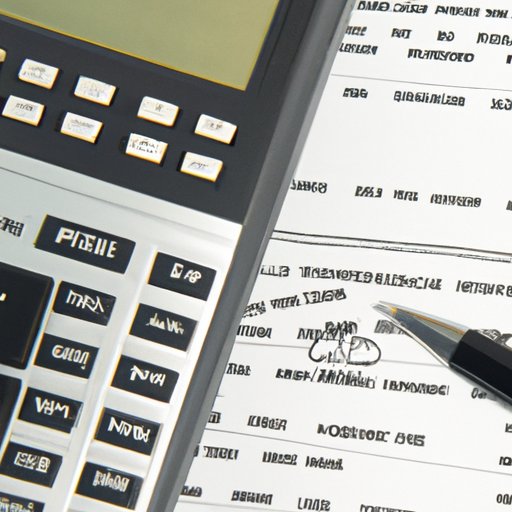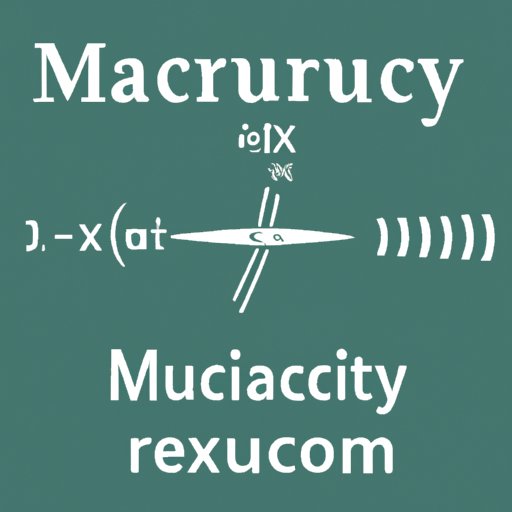
Introduction
Have you ever taken a measurement or done an experiment, only to realize later that something went wrong? Maybe the results didn’t match what you expected, or you weren’t sure how to interpret the data. This is where error calculation comes in – a process for quantifying and analyzing the errors that can affect any measurement or experiment. By understanding how to calculate error, you can achieve greater accuracy, reliability, and confidence in your results. This article will provide a comprehensive guide to error calculation, from the basics to advanced techniques, with practical tips and real-world examples.
Understanding the Basics of Error Calculation: A Step-by-Step Guide
The first step in calculating error is understanding the key terms involved. In any measurement or experiment, there is a true value – the actual or expected value, based on theory or previous data. Measurement is the process of obtaining a value through observation or measurement. Error is the difference between the measured value and the true value.
Precision is the degree of agreement or consistency among multiple measurements of the same quantity, while accuracy is the degree of agreement or closeness between a measured value and the true value. For example, a measurement that is both precise and accurate would be very close to the true value and have very little variation among repeated measurements.
One common way to express error is as a percentage of the true value, known as percent error. To calculate percent error, subtract the true value from the measured value, divide by the true value, and multiply by 100. Absolute error is another way to express error, calculated as the absolute value of the difference between the measured value and the true value.
To calculate errors in general, you can use a step-by-step approach. First, identify the type of error involved, such as random or systematic error. Random errors are due to fluctuations or uncertainties in the measurement process, while systematic errors are due to consistent biases or limitations in the measurement equipment or method. Next, quantify the error using statistical methods such as standard deviation, tolerance intervals, or confidence intervals. Finally, analyze the error to determine its impact on the result and any corrective actions needed.
Mistakes Happen: How to Calculate and Learn from Your Errors
It’s important to recognize that errors are inevitable in any measurement or experiment. However, by understanding different types of errors and their causes, you can take steps to minimize their impact and learn from your mistakes. Random errors can be reduced by increasing the number of measurements or using more precise equipment, while systematic errors can be minimized by calibrating equipment, using correction factors, or refining the measurement method.
To identify and quantify errors, you can use statistical methods such as regression analysis, hypothesis testing, or Bayesian inference. These techniques allow you to analyze the probability of different error sources and estimate the uncertainty in your results. It’s also important to document your errors and analyze them after each experiment or measurement, to improve your methods and prevent repeat mistakes.
The Key to Success: Utilizing Error Calculation for Accurate Results
Error calculation is not just a necessary evil, but a valuable tool for achieving accuracy and reliability in any field. One advanced technique for error calculation is error propagation, which involves estimating the error in a final result based on the errors of individual measurements or calculations. This can be done using mathematical formulas or software programs that automate the process.
In more complex calculations, such as those involving derivatives or logarithms, error calculation can be even more challenging. However, there are methods such as differentiation rules and logarithmic differentiation that can simplify the process. It’s also important to understand the principles of significant figures and rounding rules, which can help you avoid common errors in mathematical operations.
Math Made Easy: Simple Tips for Calculating Errors in Any Equation
For many equations and formulas, there are specific rules and formulas for calculating errors. For example, the Pythagorean theorem has a formula for calculating the error in the hypotenuse based on the errors in the legs. Similarly, Ohm’s law has a formula for calculating the error in the resistance based on the errors in the voltage and current.
To simplify error calculations for any equation, there are several practical tips you can follow. For addition and subtraction, the rule is to round the final result to the same number of decimal places as the least precise measurement. For multiplication and division, the rule is to use the “relative uncertainty” approach, which involves dividing the absolute uncertainty by the measured value. There are also common formulas for calculating errors in more complex equations, such as those involving exponentials or trigonometric functions.

Maximizing Accuracy: Techniques for Calculating Error in Scientific Research
Error calculation is essential in many fields of science, especially in fields such as physics, chemistry, and biology. In research experiments, errors can come from many sources such as measurement equipment, environmental factors, or human error. To minimize and control these errors, best practices include using precise and calibrated equipment, randomizing samples, and blinding researchers to reduce bias.
Statistical methods are also important for analyzing error in scientific research, such as regression analysis and Bayesian inference. These techniques allow researchers to analyze complex data sets and identify patterns or trends that may be obscured by random error. It’s also important to use appropriate sample sizes and understand the power and limitations of statistical tests.
Pro Tips for Calculating Error in Engineering and Design
Error calculation is also critical in engineering and design, from product development to structural analysis. In engineering, errors can come from sources such as material defects, fabrication tolerances, or environmental factors. To validate design models and minimize error in simulations and prototypes, it’s again important to use precise and calibrated equipment and minimize variability in measurements.
There are also techniques such as Monte Carlo simulation that can be used to estimate the overall uncertainty in a design or process. This involves running multiple simulations with randomly generated input data and analyzing the resulting output data. This can help identify potential failure modes and estimate the probability of each outcome.
The Importance of Error Calculation in Financial Planning and Analysis
Finally, error calculation is critical in finance and accounting, where errors in data can have significant consequences for individuals and organizations. Financial errors can come from sources such as incorrect data entry, forecasting errors, or model assumptions that don’t hold up in practice.
To mitigate the impact of financial errors, best practices include having multiple layers of review and validation for critical data and using statistical methods such as sensitivity analysis and scenario planning. It’s also important to recognize the limitations of financial models and assumptions, and to be transparent and clear about their uncertainties and risks.
Conclusion
In today’s data-driven world, error calculation is critical for achieving accuracy, reliability, and confidence in any field. By understanding the basics of error calculation, identifying different types of errors, and using statistical methods to quantify and analyze errors, you can improve your results and learn from your mistakes. Whether you’re in science, engineering, finance, or any other field, the principles of error calculation apply.





